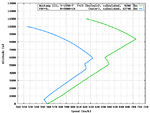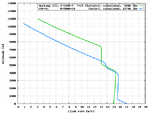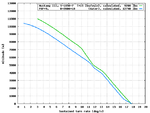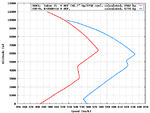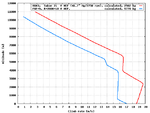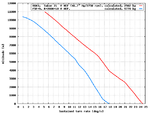I agree. The post was just echoing the sentiment the Mustang pilots had toward the P-51 and it's liquid cooled motor and other associated technical problems they had flying over the "continent".The Hellcat was undoubtedly generally more resiliant to ground fire
but 'a man with a rifle' could equally put one through the canopy of the Hellcat and kill the pilot; would one be considered a lack of resiliance to small-arms fire and the other pure luck?
Navigation
Install the app
How to install the app on iOS
Follow along with the video below to see how to install our site as a web app on your home screen.
Note: This feature may not be available in some browsers.
More options
You are using an out of date browser. It may not display this or other websites correctly.
You should upgrade or use an alternative browser.
You should upgrade or use an alternative browser.
P-51 vs. Hellcat
- Thread starter nimrod.michaeli
- Start date
Ad: This forum contains affiliate links to products on Amazon and eBay. More information in Terms and rules
More options
Who Replied?drgondog
Major
I agree. The post was just echoing the sentiment the Mustang pilots had toward the P-51 and it's liquid cooled motor and other associated technical problems they had flying over the "continent".
Amsel - my father flew two tours in the Mustang, crash landed his Mustang from 100mi behind enemy lines, then three more times progressively closer to Steeple Morden - all flak. He had zero problem with a merlin engine powered Mustang whichj took him all the way to Russia on September 18, 1944.
While he flew his share of Fighter Bomber Sweeps and Dive Bombing missions - the role of the 8th AF Mustang was to Kill The Luftwaffe. No other fighter did it better.
He much prefererred the 51 to the 47 and 38 as an ETO fighter.
Don't give too much credence to 'coolant damage fears' of Mustang pilots.
Ok. Thats the bad thing about history, seperating fact from opinion. Hats off to your father; both of my grandfathers served in the PTO as well. I was mostly referring to the memoirs of "Bud" Fortier who also flew out of Steeple Morden with the 354th. He talked of some major growing pains with the P-51 and the vulnerability of it's engine, especially compared to the radial powered fighters. I assume that many people will figure the Mustang to be the best fighter in the American arsenal as well as the Hellcat for some of the same reasons.Amsel - my father flew two tours in the Mustang, crash landed his Mustang from 100mi behind enemy lines, then three more times progressively closer to Steeple Morden - all flak. He had zero problem with a merlin engine powered Mustang whichj took him all the way to Russia on September 18, 1944.
While he flew his share of Fighter Bomber Sweeps and Dive Bombing missions - the role of the 8th AF Mustang was to Kill The Luftwaffe. No other fighter did it better.
He much prefererred the 51 to the 47 and 38 as an ETO fighter.
Don't give too much credence to 'coolant damage fears' of Mustang pilots.
drgondog
Major
DRGONDOG,
But the F6F still topped the P-51 and that is what counts.
Trivial difference over inferior opposition and most over enemy territory against the best air force the axis had. So how do you want to proceed in comparison of Zero ve Fw 190/Me 109/Me 262 as opponents?
As for your comment on strafing; different geography, different war. Lots of water in the Pacific and lots of land in Europe. The F6F would have been a much better strafer in the ETO as it was much more rugged.
Ah, but would the F6F been strafing targets east of Berlin, East of Munich? What kind of airfield defenses was the F6f strafing against? Tell me you think the flak around Japanese airfirelds was the same as German airfields?
F6Fs tore up the Japanese aircraft and airfields when they found them. Just look at the carrier raids on Japan in the summer of 45 by F6Fs, they were deadly. P-51s were great strafers in 1944-45 because they were the predominant aircraft, not because they were better ground attack aircraft than the P-47, there were just more of them.
They were DOMINANT because they combined Performance and Range. The P-38 had the same range but had pitiful ground destruction statistics in the same timeframe - despite having Two engines for flak damage redundancy. The P-47 didn't compete because they were floundering on the Dummer Lake to Stuttgart axis while 51's were ranging 300 miles further in.
ask most ETO pilots and I'll bet they'd prefer to do ground attack in the Jug than the Mustang due to the ruggedness and engine toughness issues.
Ah, but the 8th AF role was escort - and the ground assault was After Escort duties - and the P-47s by that time were landing on their home fields or getting ready to provide withdrawal support at the German/Dutch/French borders
That was a big lesson from Korea. Mustangs went down in droves from single hits. I would also contend your comment about non-common opponents. German and Japanese pilots in 1944-45 were merely fodder for either opponent because of their lack of training, whether an F6F or P-51.
Bold claim - prove it.
It is hard to say that a 109 / 190 was superior to a Ki-84, J2M, or George.
It is very easy to extablish that in 1943 and 1944... as well as the number of Experten flying them. The George was produced in extremely small numbers (,400) - how many Hellcat kills (out of 5000+)? How many K-84 encounters for Hellcats (out of 5000+ total awards?) Ditto J2M? What were the dominant air to air awards for the Hellcat? Comparable to thr Fw 190/Me 109. How many hellcat kills against torpedo or level bombers in AIRCAP?
In fact the 109 would probably pale in comparison to any of these.
Well, in a word (or several) the Me 109G and K did not 'pale in comparison', neither were the Fw 190A-7 and A-9 and D-9 - if you think so - make your case?
The pilot would make all the difference and at that late date when the Mustang ran up its scores they were flying against pilots and planes that were hardly a match for them, much like the F6F against and Japanese opponents in the same timeframe.
Take a hard look at when the P-51 made 80% of its scores - long before 1945. In 1945 the LW basically pulled back Defense of the Reich from the West and devoted much of its strength against USSR. My father saw enemy fighters (in the distance) once in 1945. You want to match Luft Flotte Reich fighter pilots skills (and numbers) against IJN in Dec 1943 -Dec 1944?
Make your case with facts - not generalities..
drgondog
Major
Ok. Thats the bad thing about history, seperating fact from opinion. Hats off to your father; both of my grandfathers served in the PTO as well. I was mostly referring to the memoirs of "Bud" Fortier who also flew out of Steeple Morden with the 354th. He talked of some major growing pains with the P-51 and the vulnerability of it's engine, especially compared to the radial powered fighters. I assume that many people will figure the Mustang to be the best fighter in the American arsenal as well as the Hellcat for some of the same reasons.
Go back and re-read it and reflect on Bud's comments about my father Bert Marshall..
Bud was one of the best and one of the very few that started ops at Steeple Morden in 1943 and finished when the war ended. Bud loved the 51. He got all of his scores (save 1/3 of a shared kill on his last mission in a Jug) in the Mustang.
Njaco
The Pop-Tart Whisperer
Was the main difference between PTO and ETO fighters the ability to land on carriers? I mean, if one plane was good enough to take on Zekes and Fw190s, why so many different type fighters? I understand about different IPs but if the Hellcat could tangle well with 109s why wasn't it used in the ETO and vice versa?
That's a question I used to wonder about too. Part of it was the landing on Carriers thing, Carrier birds had to have good low speed handling. That usually translates into lots of lift and a big, wide wing. Also, the Navy liked radial engines because they saw them as more reliable. No pluming system to cool gave you one less problem to deal with and one less thing to fail.
The Army liked inline engines because they lead to less draggy airframes and that translated into speed. Big thing for Army fighters, not so important for the bombers (where reliability was more important). However, as power increased, (and other aerodynamic changes) the down side of a blunt front mattered less and less. Hence the P47.
But that doesn't explain the Corsair. Good leggs, far enough along in the development process to be a good, long range fighter when the USAAF needed one but never got there. With drop tanks, it could probably make it as far as Berlin (a guess there). But it never happend.
I used to know the answer, but forgot.
The Army liked inline engines because they lead to less draggy airframes and that translated into speed. Big thing for Army fighters, not so important for the bombers (where reliability was more important). However, as power increased, (and other aerodynamic changes) the down side of a blunt front mattered less and less. Hence the P47.
But that doesn't explain the Corsair. Good leggs, far enough along in the development process to be a good, long range fighter when the USAAF needed one but never got there. With drop tanks, it could probably make it as far as Berlin (a guess there). But it never happend.
I used to know the answer, but forgot.
ONE_HELLCAT
Airman 1st Class
I also heard the navy preferred radial engines because glycol is flammable, and that's one less hazard on a ship. I noticed in IL-2 that a few hits to the glycol tank on the Mustang causes the plane to explode, but that's just a game and I don't know how well the actually translated into real life.
renrich
Chief Master Sergeant
Interesting stats on Hellcat. Flew 66530 sorties with 553 losses to AA, 270 to AC and 340 operational. It shot down 1445 bombers and 3718 fighters. A question would be how many fighters that were acting as kamikazes? My guess is that the bag of the P51 shows a lot higher proportion of fighters and no kamikazes in the ETO. No doubt in my mind as to the degree of difficulty. The overall quality of Japanese pilots went steeply downhill after mid 1943 although obviously there were some of the old timers such as Saburo still around at the end. Prior to the Leyte Gulf battle some of the IJN pilots could barely execute a carrier landing. The Hellcat was a formidable ACM AC and probably would have held it's own in the ETO as a fighter bomber and low and medium altitude fighter but there was no way it could fill the role of a long range escort fighter working at altitudes of 20 to 30000 feet as well as the Mustang. The truth is that the Hellcat was a kind of easy going work horse that could do a lot of things fairly well, including carrier landings, but was not especially stellar at anything. The Hellcat had good visibility, better than the P51B or C because the pilot sat high with good visibility over the nose. Probably not as good overall as the P51D.
renrich
Chief Master Sergeant
A quote from a WW2 pilot comparing the Corsair versus the Hellcat. "The Corsair was a high strung predator while the Hellcat was a nice safe pussycat." In comparing the Hellcat versus the Mustang, the Hellcat was very good at the job it was designed for; a reliable, rugged, easy to maintain, easy to fly, carrier fighter which had the necessary performance edge over most of the enemy. The Mustang came to be the premier long range escort fighter of the war. Neither would have been outstanding at the other's mission.
drgondog
Major
That's a question I used to wonder about too. Part of it was the landing on Carriers thing, Carrier birds had to have good low speed handling. That usually translates into lots of lift and a big, wide wing. Also, the Navy liked radial engines because they saw them as more reliable. No pluming system to cool gave you one less problem to deal with and one less thing to fail.
The USN did prefer radial engines and never purchased an aircraft with an in-line engine AFAIK.
True about low speed handling characteristics being a critical part of USN design specifications - more attention paid to flaps as the wings weren't uncontrained as far as drag. The a/c still needed range and performance so, except for folding criteria for storage the wings were designed largely the same way a USAAF fighter would have been designed.
The Army liked inline engines because they lead to less draggy airframes and that translated into speed. Big thing for Army fighters, not so important for the bombers (where reliability was more important). However, as power increased, (and other aerodynamic changes) the down side of a blunt front mattered less and less. Hence the P47.
Remember the P-35 and P-43 were also radial engines. The USAAF specs in the mid to late 30's were for aitcraft more suited to close air support - only the P-38 and P-47 were designed to be high altitude performers, and of course the P-51 was not designed to a USAAF spec.
Remember the USAAF 'didn't need long range escort' so long range, high performance was deemed 'solved' by P-38.
But that doesn't explain the Corsair. Good leggs, far enough along in the development process to be a good, long range fighter when the USAAF needed one but never got there. With drop tanks, it could probably make it as far as Berlin (a guess there). But it never happend.
I used to know the answer, but forgot.
It was a USN ship.
The Army didn't buy Navy and the Navy didn't buy Army except when there was no other choice (B-25 for USMC and PB4-Y modified B-24 for USN patrol bomber, plus A-24/SBD for USAAF)
Soundbreaker Welch?
Tech Sergeant
Neither would have been outstanding at the other's mission.
It would have been pretty interesting if they had tried to put folding wings on a P-51!
renrich
Chief Master Sergeant
An interesting comparison between Hellcat and P47, somewhat similar AC playing somewhat similar roles. There were 12275 F6Fs manufactured and they flew around 66500 sorties, almost all in the PTO. There were 15683 Jugs built and they flew around 423400 sorties in the ETO and some more in the PTO. That means that each Hellcat flew 5.42 sorties if each flew the same amount. (Not true) Each Jug flew 27 sorties if you don't count the PTO. Hmmmmm? On the face of it the Jug was a lot better value for the taxpayer. Another statistical curiosity. There were around forty US carriers of all sizes in WW2. Most of the Hellcat service was off of carriers. If we say the average carrier had 20 Hellcats, taking into account CVLs and CVEs, that accounts for 800 Hellcats. The Hellcat only had a total of 591 AC lost. What were they doing with the other more than 11000 Hellcats. Is there some cave somewhere that is full of Hellcats or maybe an AC graveyard called Hellcat Heaven. The Jug had 3077 losses in the ETO which makes the number easier to reconcile. I sense a scandal here.
I'm a lurker here, but having just finished Saburo's book of WWII exploits, I remember the section where he first encountered the Hellcat. Saburo, at this stage was a one eyed pilot but was the master of his mount, the Zero. And, he encountered a sky full of Hellcats. So, he dipped into his arsenal of Zero tricks and was surprised when those maneuvers were matched by the enemy. If the US Navy pilots could have shot, I guess shooting is something only learned with time in combat, he would not have lived to write his book or so he says.
My wife bought me a model set of two planes for Christmas, a 109 and a
F6F – a strange combination. Anyway, the horizontal tail surfaces on the
F6F as compared to the 109 are huge. Maybe this was needed for slow speed landings on a carrier or maybe it was to allow the pilot to pull more gees. The F6F model almost looks like it has four wings.
To get to the question under discussion, as the Mustang pilot, I wouldn't want to be pulled into a low maneuver fight with the F6F if it can follow a Zero. I'd want to be high and fast. Otherwise, it would be time to run away.
My wife bought me a model set of two planes for Christmas, a 109 and a
F6F – a strange combination. Anyway, the horizontal tail surfaces on the
F6F as compared to the 109 are huge. Maybe this was needed for slow speed landings on a carrier or maybe it was to allow the pilot to pull more gees. The F6F model almost looks like it has four wings.
To get to the question under discussion, as the Mustang pilot, I wouldn't want to be pulled into a low maneuver fight with the F6F if it can follow a Zero. I'd want to be high and fast. Otherwise, it would be time to run away.
Hi Nimrod,
>if the two were to fight who do you think would win
The Mustang, at least more often than the Hellcat.
Here is a comparison, based on the F6F data from here ...
http://www.ww2aircraft.net/forum/te...d-corsair-vs-grumman-f6f-5-hellcat-17293.html
... and on Mustang III data from a British comparison of Hornet I, Meteor III, Spitfire XIV and Mustang III.
(The Mustang III is a well-streamlined non-bubbletop version with a relatively light weight, so it looks rather favourable. On the other hand, the British data is for just +15 lbs/sqin, not for the +18 lbs/sqin the Mustang was cleared for later.)
Regards,
Henning (HoHun)
>if the two were to fight who do you think would win
The Mustang, at least more often than the Hellcat.
Here is a comparison, based on the F6F data from here ...
http://www.ww2aircraft.net/forum/te...d-corsair-vs-grumman-f6f-5-hellcat-17293.html
... and on Mustang III data from a British comparison of Hornet I, Meteor III, Spitfire XIV and Mustang III.
(The Mustang III is a well-streamlined non-bubbletop version with a relatively light weight, so it looks rather favourable. On the other hand, the British data is for just +15 lbs/sqin, not for the +18 lbs/sqin the Mustang was cleared for later.)
Regards,
Henning (HoHun)
Attachments
ONE_HELLCAT
Airman 1st Class
I'm sure colorful graphs would tell you the B-239 performed worse than its Russian competitors, yet the Finns were beating the Russians. Obviously the pilot can really turn the tide in a fight.
I understand the Hellcat isn't the do everything airplane people are trying to portray. It was built to survive a beating, be easy to fly, and easy to produce, and to replace the aging Wildcat.
That being said, I think a good pilot in the Hellcat could frustrate a talented Mustang pilot, and then exploit a mistake. Of course, it could always go the other way.
I understand the Hellcat isn't the do everything airplane people are trying to portray. It was built to survive a beating, be easy to fly, and easy to produce, and to replace the aging Wildcat.
That being said, I think a good pilot in the Hellcat could frustrate a talented Mustang pilot, and then exploit a mistake. Of course, it could always go the other way.
To get to the question under discussion, as the Mustang pilot, I wouldn't want to be pulled into a low maneuver fight with the F6F if it can follow a Zero. I'd want to be high and fast. Otherwise, it would be time to run away.
Barney said the above...... I don't think it could be said better.
Barney said the above...... I don't think it could be said better.
Hi Hellcat,
>I'm sure colorful graphs would tell you the B-239 performed worse than its Russian competitors, yet the Finns were beating the Russians. Obviously the pilot can really turn the tide in a fight.
"Colourful" graphs have always been the means of judging the quality of fighters, and it would be stupid to ignore them:
WWII Aircraft Performance
The Finns beat the Russians were incompetent and the Finns were not.
Take two equally competent pilots, and the winner will most likely be the guy in the superior performing fighter - in this case, the Mustang.
Regards,
Henning (HoHun)
>I'm sure colorful graphs would tell you the B-239 performed worse than its Russian competitors, yet the Finns were beating the Russians. Obviously the pilot can really turn the tide in a fight.
"Colourful" graphs have always been the means of judging the quality of fighters, and it would be stupid to ignore them:
WWII Aircraft Performance
The Finns beat the Russians were incompetent and the Finns were not.
Take two equally competent pilots, and the winner will most likely be the guy in the superior performing fighter - in this case, the Mustang.
Regards,
Henning (HoHun)
Hi Tpikdave,
>>To get to the question under discussion, as the Mustang pilot, I wouldn't want to be pulled into a low maneuver fight with the F6F if it can follow a Zero. I'd want to be high and fast. Otherwise, it would be time to run away.
>Barney said the above...... I don't think it could be said better.
"... if it can follow a Zero" - oh well, it can't, not in a turn, not even remotely.
Here's the gen.
Regards,
Henning (HoHun)
>>To get to the question under discussion, as the Mustang pilot, I wouldn't want to be pulled into a low maneuver fight with the F6F if it can follow a Zero. I'd want to be high and fast. Otherwise, it would be time to run away.
>Barney said the above...... I don't think it could be said better.
"... if it can follow a Zero" - oh well, it can't, not in a turn, not even remotely.
Here's the gen.
Regards,
Henning (HoHun)
Attachments
Users who are viewing this thread
Total: 1 (members: 0, guests: 1)
Similar threads
- Replies
- 30
- Views
- 7K

